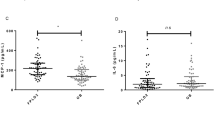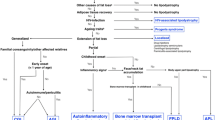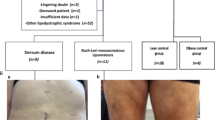Abstract
Background
Impaired production of adipocytokines is a major factor incriminated in the occurrence of lipodystrophy (LD).
Objective
To evaluate LD prevalence and subtypes in HIV treatment-multiexperienced patients, and to determine the correlations between adipocytokines and LD subtypes.
Methods
Cross-sectional study in a Romanian tertiary care hospital, between 2008 and 2010, in HIV-positive patients, undergoing cART for ≥6 months. LD diagnosis, based on clinical and anthropometric data, was classified into lipoatrophy (LA), lipohypertrophy (LH) and mixed fat redistribution (MFR). Blood samples were collected for leptin, adiponectin and resistin assessments.
Results
We included 100 patients, 44 % with LD, among which LA had 63 %. LA patients had sex ratio, median age, treatment duration and median number of ARV regimens of 1, 20, 93 and 3.5 compared to non-LD patients: 1.65, 31, 44 and 1. LH and MFR patients were older and had higher total and LDL cholesterol versus non-LD patients. For both overall group and female group, LA was associated in univariate and multivariate analysis with increased resistin (p = 0.02 and 0.04) and number of ARV regimens (p < 0.001). Determination coefficient (Nagelkerke R 2) of increased resistin and the number of ARV combinations in the presence of LA was 33 % in overall group and 47 % in female patients.
Conclusions
In our young HIV-positive population, LD had high prevalence with predominance of LA subtype. LA was associated with high resistin levels and greater number of ARV regimens in overall group and female subgroup. Resistin could be used as a marker of peripheral adipose tissue loss and might be used as a target for new anti-LD therapeutic strategies.
Similar content being viewed by others
Abbreviations
- cART:
-
Combined antiretroviral therapy
- ARV:
-
Antiretroviral therapy
- BMI:
-
Body mass index
- ELISA:
-
Enzyme-linked immunosorbent assay
- EASIA:
-
Enzyme Amplified Sensitivity Immunoassay
- HDL:
-
High-density lipoprotein
- HIV:
-
Human immunodeficiency virus
- IQR:
-
Interquartile range
- LA:
-
Lipoatrophy
- LD:
-
Lipodystrophy
- LDL:
-
Low-density lipoprotein
- LH:
-
Lipohipertrophy
- MFR:
-
Mixed fat redistribution
- SPSS:
-
Statistical Package for the Social Sciences
References
Mallewa JE, Wilkins E, Vilar J et al (2008) HIV-associated lipodystrophy: a review of underlying mechanisms and therapeutic options. J Antimicrob Chemother 62:648–660
Omolayo O, Sealy PL (2008) HIV lipodystrophy syndrome. Hosp Physician 44(5):7–14
Jianu DM (2012) A new scientific era in biomedicine—regenerative surgery based on lipotransplant. New therapeutic horizons for HIV-positive patients. GERMS 2(4):135–136
Georg Behrens, Reinhold E (2011) Schmidt. Lipodystrophy syndrome. Chapter 8 HIV In: Christian Hoffmann and Jürgen K. Rockstroh (ed) Medizin Fokus Verlag, Berlin
Galescu O, Bhangoo A, Ten A (2013) Insulin resistance, lipodystrophy and cardiometabolic syndrome in HIV/AIDS. Rev Endocr Metab Disord 14(2):133–140
Carr A, Emery S, Law M et al (2003) An objective case definition of lipodystrophy in HIV-infected adults: a case-control study. Lancet 361:726–735
Barbaro G (2006) Metabolic and cardiovascular complications of highly active antiretroviral therapy for HIV infection. Curr HIV Res 4:79–85
Sweeney LL, Brennan AM, Mantzoros CS (2007) The role of adipokines in relation to HIV lipodystrophy. AIDS 21:895–904
Samaras K (2008) Metabolic consequences and therapeutic options in highly active antiretroviral therapy in human immunodeficiency virus-1 infection. J Antimicrob Chemother 61:238–245
Escote X, Miranda M, Veloso S et al (2011) Lipodystrophy and insulin resistance in combination Antiretroviral treated HIV-1–infected patients: implication of resistin. J Acquir Immune Defic Syndr 57(1):16–23
World Health Organization (2000) Obesity: preventing and managing the global epidemic. Technical Report Series No. 894. WHO, Geneva
The IDF consensus worldwide definition of the metabolic syndrome. International Diabetes Federation 2006. http://www.idf.org/webdata/docs/IDF_Meta_def_final.pdf. Accessed Sept 2012
HIV/AIDS Monitoring and Evaluation Department of the National AIDS Comission for Romania—http://www.cnlas.ro/images/doc/epidemiology_sept2011.pdf. Accessed Sept 2011
Country Progress Report on AIDS January 2010–December 2011. http://www.unaids.org/en/dataanalysis/monitoringcountryprogress/progressreports/2012countries/ce_RO_Narrative_Report.pdf. Accessed Sept 2012
Paraschiv S, Foley B, Otelea D (2011) Diversity of HIV-1 subtype C strains isolated in Romania. Infection, genetics and evolution. J Mol Epidemiol Evol Genet Infect Dis 11(2):270–275
Arama V, Tiliscan C, Streinu-Cercel A et al (2013) Insulin resistance and adipokines serum levels in a Caucasian cohort of HIV-positive patients undergoing antiretroviral therapy: a cross sectional study. BMC Endocr Disord 13:4
Degawa-Yamauchi M, Bovenkerk JE, Juliar BE et al (2003) Serum resistin (FIZZ3) protein is increased in obese humans. J Clin Endocrinol Metab 88(11):5452–5455
Youn BS, Yu KY, Park HJE et al (2004) Plasma resistin concentrations measured by enzyme-linked immunosorbent assay using a newly developed monoclonal antibody are elevated in individuals with type 2 diabetes mellitus. J Clin Endocrinol Metab 89(1):150–156
Barb D, Wadhwa SG, Kratzsch J et al (2005) Circulating resistin levels are not associated with fat redistribution, insulin resistance, or metabolic profile in patients with the highly active antiretroviral therapy-induced metabolic syndrome. J Clin Endocrinol Metab 90(9):5324–5328
Spagnuolo MI, Caiazzo MA, Franzese A et al (2010) Side effects of highly active antiretroviral therapy in children with AIDS: phase angle alpha, serum resistin levels, and ultrasound as predictors of malnutrition. Nutr Ther Metab 28(4):193–197
Fiorenza CG, Chou SH, Mantzoros CS (2011) Lipodystrophy: pathophysiology and advances in treatment. Nat Rev Endocrinol 7:137–150
Tsiodras S, Mantzoros C (2006) Leptin and adiponectin in the HIV associated metabolic syndrome: physiologic and therapeutic implications. Am J Infect Dis 2(3):141–152
Kelesidis T, Kelesidis I, Chou S, Mantzoros CS (2010) Narrative review: the role of Leptine in human physiology: emerging clinical applications. Ann Intern Med 152(2):93–100
Kosmiski L, Kuritzkes D, Lichtenstein K, Eckel R (2003) Adipocyte-derived hormone levels in HIV lipodystrophy. Antivir Ther 8:9–15
Resino S, Micheloud D, Lorente R, Bellon JM, Navarro ML, Munoz-Fernandez MA (2011) Adipokine profiles and lipodystrophy in HIV-infected children during the first 4 years on highly active antiretroviral therapy. HIV Med 12:54–60
Acknowledgments
The authors thank all patients that agreed to participate in this study and all the study team for their contribution to the research, as well as all the medical staff involved in this study, especially: Ioana Diana Olaru, Cristina Loredana Benea, Anca Streinu Cercel, Mihaela Radulescu for their implication in recruiting and in the follow-up of the patients, and Viorica Leoveanu (deceased) for performing the assessments for the adipocytokines. The study was funded by the National Authority for Scientific Research (Grant No. 62077/2008, 2008–2011). Coordinating center: Prof. Dr. Matei Bals National Institute of Infectious Diseases, Bucharest, Romania. Project Manager: Prof. Adrian Streinu Cercel. Scientific coordinator: Assoc. Prof. Victoria Arama.
Conflict of interest
The authors declare that they have no conflicts of interest.
Author information
Authors and Affiliations
Corresponding author
Rights and permissions
About this article
Cite this article
Arama, V., Munteanu, D.I., Streinu Cercel, A. et al. Lipodystrophy syndrome in HIV treatment-multiexperienced patients: implication of resistin. J Endocrinol Invest 37, 533–539 (2014). https://doi.org/10.1007/s40618-014-0057-x
Received:
Accepted:
Published:
Issue Date:
DOI: https://doi.org/10.1007/s40618-014-0057-x




